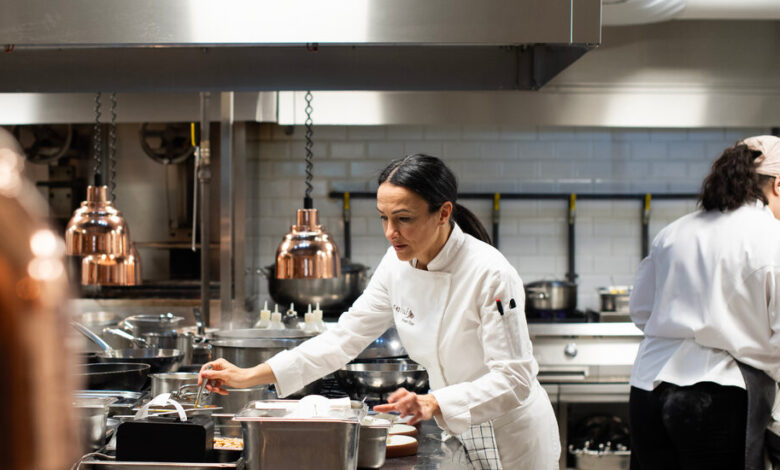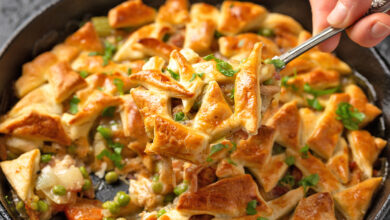How Female Chefs Are Sparkling in Istanbul

No bigger than chickpeas and blanketed with tangy yogurt and sizzling spiced butter, the manti were so good they could be inhaled by the dozen. My partner, Barry, and I devoured these lamb-filled Turkish dumplings, shaped into cute tufted shells, at Hatice Anne Ev Yemekleri, a homey spot in Istanbul’s Kuzguncuk neighborhood.
“There are so many unsung female cooks in this city,” said Benoit Hanquet as we saluted Merve Ataoglu, the restaurant’s kerchiefed manti maker. Mr. Hanquet, our guide for a Culinary Backstreets food tour of Istanbul, would later lead us on to Gule Kafe (fried doughnuts and crumbly sesame cookies) and Gunesin Sofrasi (a tasty mosaic of meze) — two more establishments serving delicious treats and overseen by women.
Exploring a city through its diverse restaurants is always rewarding. But inspired by Mr. Hanquet’s tour, I decided on a subsequent Istanbul visit to focus just on kitchens run by talented women. For all its glamour and rising international fame, Istanbul’s food world has until recently remained patriarchal — all dude celebrity chefs and swaggering ustas (masters) presiding over traditional specialties like baklava or kebab.
“Men ran professional kitchens, women were expected to cook at home for their families,” the local food media star and cookbook author Refika Birgul told me. “But with the rise of modern fine dining culture in Istanbul, that dynamic is finally changing.”
Indeed. In the decade and a half that I’ve spent time in this city, I’ve seen a generation of female chefs emerge, quietly defining Istanbul’s sophisticated style of cuisine — an idiom that often involves creative takes on Anatolian ingredients such as yogurt, tahini and pomegranate. And so, revisiting old favorites and checking out newcomers, I crossed the city in routes lit by female culinary star power.
Istanbul’s historical peninsula, the city’s old Byzantine-Ottoman core of imperial mosques and bazaars, dominated by the magnificence of the Hagia Sophia, is tourist central. Locals, however, barely come here, unless it’s to buy wedding gold at the Grand Bazaar — or to dine at Giritli. This modern meyhane (tavern) still feels like a delicious discovery, even after nearly two decades in business. Occupying a 19th-century Ottoman mansion and idyllic garden, Giritli is owned by the pioneering chef and restaurateur Ayse Sensilay, whose roots are in Crete (Giritli means Cretan in Turkish). Drawing on Hellenic family recipes and Istanbul’s multicultural heritage, Ms. Sensilay constantly updates familiar flavors: Black eye peas, a traditional Aegean ingredient, come unexpectedly laced with tangy dried apricot slivers; cacik, a classic yogurt dip, is packed with juicy purslane and green almonds instead of the usual cucumbers.
Giritli’s prix-fixe dinner involves a constellation of meze and mains. For lunch one can go à la carte, as we did, eating a pile of crisp fried zucchini followed by a bowl of seafood-studded orzo pilaf — and then a grilled local bluefish called lufer. As we finished our dessert of caramelized quince, Ms. Sensilay swept in, an arty grande dame in stylish red glasses.
“When I started in the restaurant business, it was so hard for women,” she said.
“The new generation is luckier. They can now get exceptional professional training,” she continued. “Plus modern food styles offer more creativity — appealing to women because we are innovators and reformists by nature.”
Prix-fixe dinner from 1,200 TL per person, or $40; lunch for two around 1,800 TL.
Across the Golden Horn, the Beyolgu quarter has always been Istanbul’s party and restaurant playground. Its current culinary star is Cigdem Seferoglu, who opened Hodan in 2021 in the basement space of an elegant 1901 building. With white tablecloths, an open kitchen, a tree rising from the floor and contemporary Turkish art (including a fantastical origami chandelier), Hodan has the air of a glamorous indoor-outdoor brasserie.
Riffs on traditional cuisines at our table included a pomegranate and cucumber salad crowned with a scoop of bracingly tart sour cherry sorbet, and fluffy truffled taramosalata on toast. Next came grilled octopus, diced and laced with snappy green olives, and a flame-kissed pide (flatbread) topped with unctuous tidbits of kokorec (that’s, umm, roasted intestines), a gutsy homage to Istanbul street food. A voluptuous tiramisu decorated with rose petals and grassy-green local pistachios saw us off into the night, past the party kids shuffling in and out of nearby nightclubs.
Dinner for two around 1,900 TL.
One wouldn’t think of going for Asian food in this city. Yet delicious raw-fish dishes and robata skewers can be enjoyed at Roka Galataport, overseen by the gifted executive chef, Suna Hakyemez, a veteran of the renowned Fat Duck in England.
And one evening we took a scenic ride on the Bosporus water shuttle to the Bebek neighborhood, to eat at Sankai by Nagaya. This Asian newcomer was awarded a Michelin star within eight months of its opening last March. At the Bebek Hotel, we were handed a room key card to enter Sankai’s serene third-floor, 24-seat dining room with glittering watery vistas. In its open kitchen, the sushi shokunin (artisan) Hiroko Shibata was flashing supernatural knife skills.
A protégé of the Michelin-starred Japanese chef and Sankai’s mastermind, Yoshisumi Nagaya, Ms. Shibata spent years traveling around Japan sampling regional specialties while working for the Japanese navy. After an early retirement, she pursued her fish obsession in the equally male-dominated world of sushi. “Male colleagues were so uncomfortable seeing me in the kitchen!” she recalled with a laugh. “But they had to get used to it.”
While most sushi spots in Istanbul import their seafood, Ms. Shibata insists on catch that’s exclusively local. Our omakase kicked off with kaiseki-style morsels, including an adorable crab-and-shrimp doughnut frosted with Black Sea trout roe. The sashimi-course standouts were alabaster petals of pristine sea bass from the Marmara Sea and buttery nuggets of palamut (bonito). From the Aegean came the chopped fatty tuna and plump langoustines in Ms. Shibata’s elegant maki rolls.
After our elaborate chestnut dessert, we asked Ms. Shibata if she was learning Turkish.
“Mostly the bad words I picked up from the fishermen,” she replied.
Tasting menus from 4,500 TL per person.
North of Bebek, the leafy waterside enclave of Yenikoy was only recently a sleepy area of traditional bakeries and fish restaurants with white-jacketed waiters. Now it’s a dining destination, thanks in part to such female-run restaurants as the Michelin-starred Araka, and the charming Apartiman, owned by the chef Burcak Kazdal and her brother, Murat. With a citrus-scented back garden, Apartiman was converted by the Kazdals in 2017 from an old apartment building, and now it buzzes nightly with young locals and food industry types. The vibe is so welcoming, strangers soon feel like regulars.
A former baker, shepherd and butcher who lived and worked in San Francisco and England, Ms. Kazdal has an eclectic personal cooking style, inspired by travels, old cookbooks and her special suppliers.
That style was on delicious display in our appetizers of flavorful celery root roasted with pekmez (grape molasses) and miso and brightened with pickled radishes; and in the lightly smoked horse mackerel served over borlotti beans, grapes, and jagged sourdough croutons that sopped up the warm vinaigrette underneath. As for the eriste (traditionally cut Turkish noodles) cooked in duck stock and topped with melting shreds of pulled duck and wedges of palate-cleansing persimmon, it’s the kind of soulful comfort food I’d welcome every day.
Dinner for two around 2,000 TL.
Our final stop was in Vadi, an inland district of glossy skyscrapers and megamalls, to dine at Seraf Vadi. The restaurant’s owner, Dogan Yildirim, is a Kurdish restaurateur so obsessed with gastronomic authenticity he kept dismissing chefs until he offered the job to his business manager, Sinem Ozler. Ms. Ozler, who was a prodigious home cook, traveled all over Turkey to research regional specialties for the menu at Seraf Vadi. Hence, the dishes on her current menu include Azeri hengel (floppy hand-rolled noodles with caramelized onions) from the Turkish-Armenian border, and yaglama (layers of wood-fired flatbreads moistened with tomatoe-y beef) from the central Anatolian city of Kayseri.
Even such familiar classics as dolma, icli kofte (meat-filled bulgur dumpling) and lahmacun (“Turkish pizza”) are elevated by exalted ingredients and attention to detail. It’s a thrill to savor these rootsy Anatolian flavors in a high-design room accompanied by unique Turkish wines. Sabiha Apaydin, one of the country’s top wine experts, created the restaurant’s 240-label list.
“Traditional Turkish cuisine is often served in humble surroundings, no alcohol,” Ms. Ozler said. “Here we are proud to give it a beautiful home it deserves.”
At Seraf Vadi, our food journey ended with the dish that had launched it — manti, finished in a wood-burning oven for a perfect ratio of crisp dough to succulent lamb filling. It was a dish to inspire a food pilgrimage, and a testament to the culinary prowess of Istanbul’s female cooks.
Dinner for two around 2,200 TL. Given Turkey’s current rate of inflation, all prices listed in this article are approximate and do not include alcohol and service.
Follow New York Times Travel on Instagram and sign up for our weekly Travel Dispatch newsletter to get expert tips on traveling smarter and inspiration for your next vacation. Dreaming up a future getaway or just armchair traveling? Check out our 52 Places to Go in 2024.





